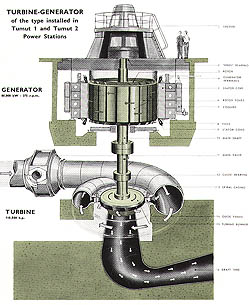|
The completion of the Snowy Mountains Hydro-electric
Scheme (SMHES) in 1974 marked the realisation of a long
held desire to utilise the waters of the Snowy River
and other mountain rivers fed by melting snows from
the alpine region of south eastern Australia. It was
also a project that embodied many of the ideals of post
World War II Australia, such as:
- industrial
growth
- control
of the environment
- modern
'efficient' work practices
- nationalism
- modern
design
The
project also brought together people from many countries,
helping to lay the foundation for the multicultural
Australia of today.
Irrigation
and electrical power
The Scheme is designed to provide both irrigation water
for the drought-prone inland regions of NSW and electrical
power for Australia's industries and homes. River water
is captured and diverted westward through a series of
dams, reservoirs and tunnels. Along the way the water
passes through seven power stations, turning hydro-electric
turbines to generate electricity.
When
the project was commenced in 1949, it was presented
as a national milestone. Australian Prime Minister Ben
Chifley declared that Australia was "on the threshold
of a new era of great industrial and rural development".
Immigration
Minister Arthur Calwell had earlier outlined the government's
ideal for a society held together by a high standard
of living, which would be provided in part by modern
labour-saving devices manufactured in Australia. To
produce and run these modern conveniences, electrical
power was needed. Meanwhile, the country's growing population,
boosted by immigration, would be fed by increased agricultural
productivity from the well-watered farmlands.
Producing
electricity
Turbines
The turbine turns the energy stored in a moving
fluid into mechanical energy. In a hydro-electric
power station, water falling under pressure from
a river or pressure pipes enters the station through
a large valve and spiral pipe casing. The water
strikes or passes through a series of turbine blades.
The pressure of the water spins the blades, and
the blades turn a shaft whose spinning motion is
converted by a generator into electricity. The water
is discharged from the power station through draft
tubes, which are located below the turbine. |
|

Section
of turbine-generator
(SMA, 1961: 15) Click to view larger diagram
|
|
Transmission
of electricity
The electricity goes to a transformer where it is
changed from low voltage to high voltage. The transformer
is a device that transfers energy from one electric
circuit to another without changes of frequency
and usually with a change in voltage. Then, the
electricity enters the cables, which conduct the
current. |
|

330k
Transmission system in the Snowy Mountains
area
(SMA, 1993: 160) Click
to view larger diagram
|
|
After
the electricity has been produced, it is sent via a
power distribution grid to customers who generally live
hundreds of kilometres away.
Steel
towers are used on the Scheme to hang the cables. Ceramic
insulators prevented the electricity in the wires from
jumping to the towers.
Transmission
cables
Many electrical cables are made from aluminium. Wires
can be installed above or below ground.
Underground
cables are placed in pipes, which are filled with oil,
and protected with lead, PVC, and rubber sheaths. See
black pipe below.

A
section of a 333kV aluminium cable can be seen in
the figure. These cables are used at high altitudes,
where heavy icing occurs. |
|